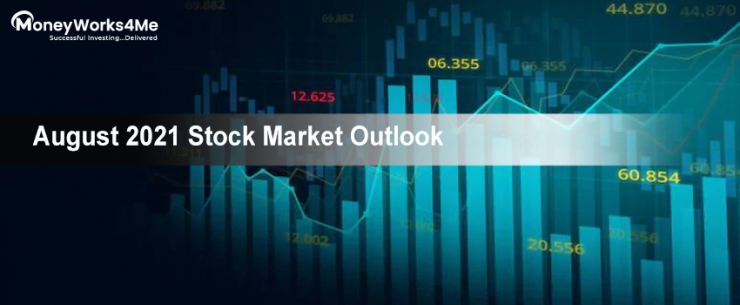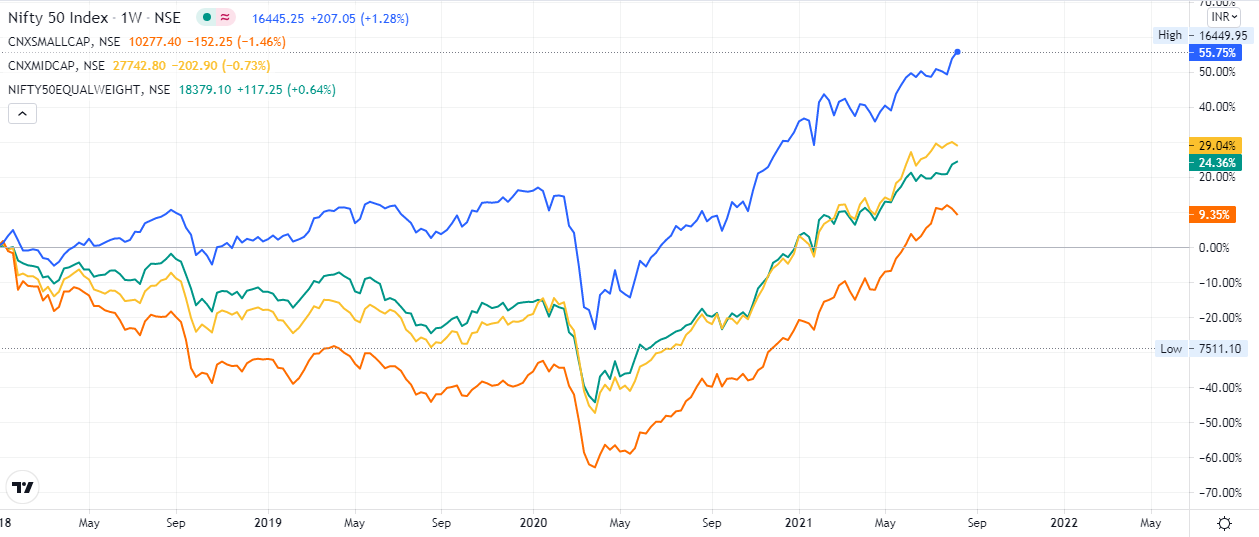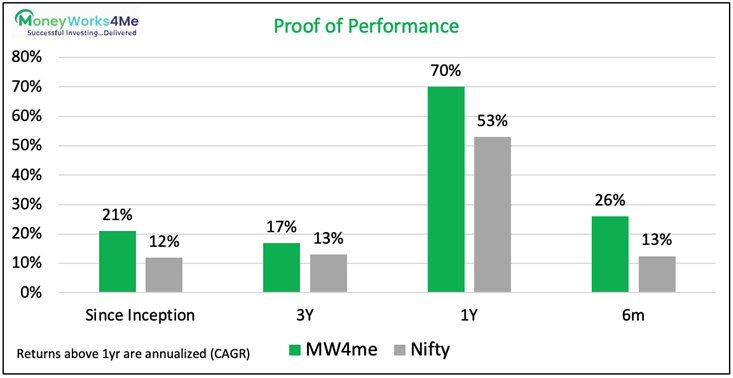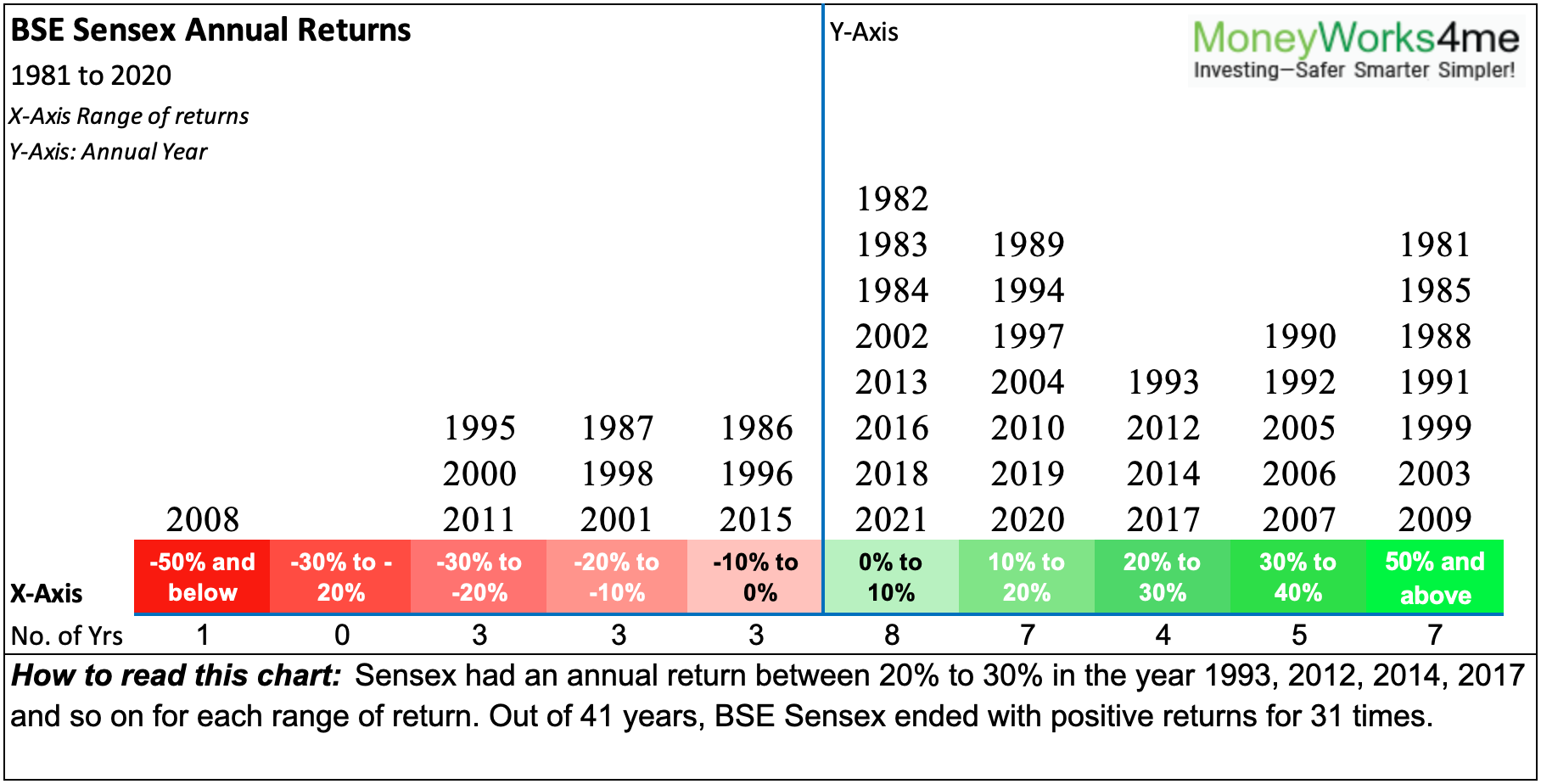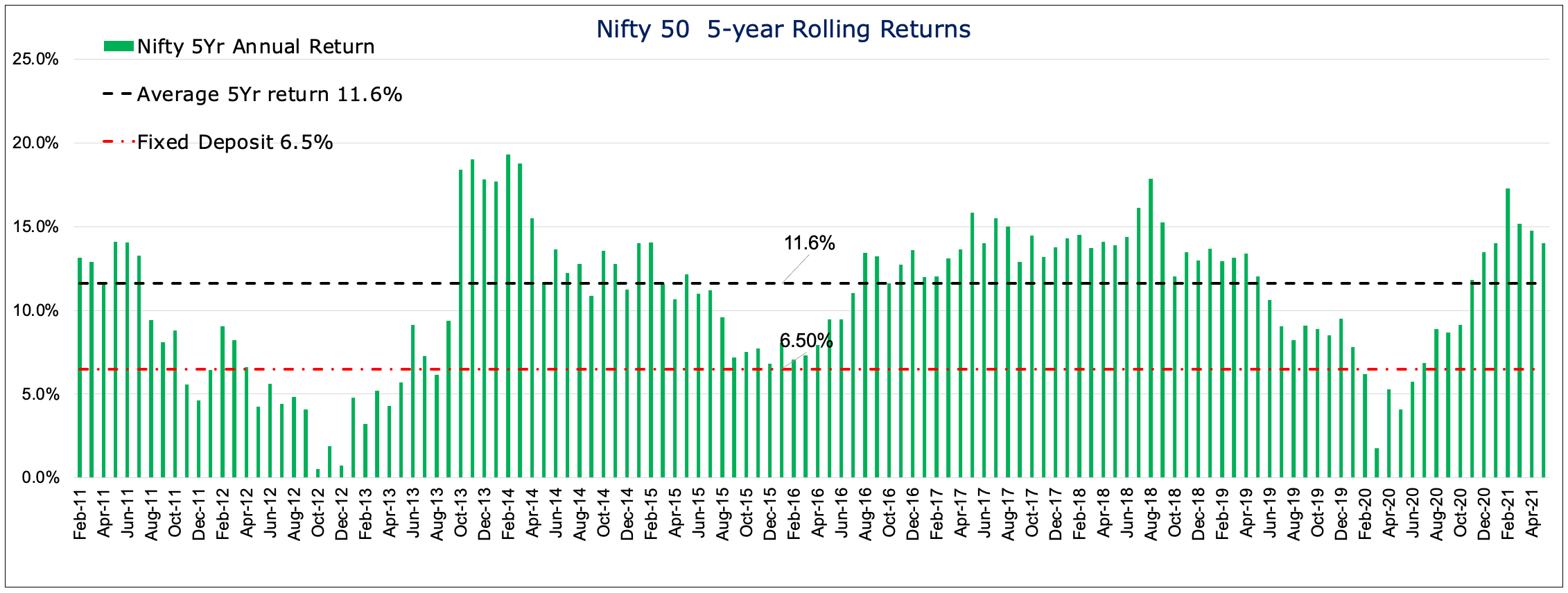This article covers the following:
Review
For the year ending Jul’21, Nifty closed at ~15,800, around 42% higher than last year. In the last 3 years, Nifty is up 40%; ~12% CAGR.
The last 1 year saw a massive shift in stock performance versus the prior 2 years where only Nifty stayed flat while the rest of the market saw correction. In the last 1 year, every segment of the market, small, mid, value, cyclical did better than Nifty. Low-interest rates globally and high investor participation in the global market have led to good gains in stocks.
Performance of small/mid-cap, capital goods, and PSU was encouraging and playing a catch up with the rest of the market. Mid/small-cap and Equal weight had a phenomenal run but it has still some ground to cover to catch up. Nifty was a tough benchmark to beat at least in the last 3 years.
Incremental macro data is improving but recovery is still patchy across various states and sectors. However, companies are in better shape to withstand any disruptions in between as last year’s event has made them more agile. We are seeing listed companies are facing lesser financial stress than small and medium scale enterprises (MSME). This bodes well for the Stock market and Nifty 100/200 EPS growth rate.
Outlook
Nifty 50 index trades above its fair value while there are pockets of extreme overvaluation and undervaluation. Nifty – led by a concentrated portfolio of Top 10 stocks – is around 31% higher than its fair price, while the same is not true for all stocks. (Nifty@MRP 11,864 Dec’20 numbers). The next update will be done after we incorporate the June Quarter results.
We are seeing a recovery in growth in the coming year so we may see an upward revision in our estimates. This can bring down overvaluation down by ~5-10%.
As of date, the average upside of our coverage universe is likely to be closer to 10% CAGR over the next 5 years basis based on a current estimate. Similar to Nifty, the average upside of our universe is low due to few stocks showing < 0% CAGR while the rest showing > 15% CAGR upside potential.
MoneyWorks4me performance was strong last year as we saw the market recognized undervaluation in pockets where we were invested. Even if we return before Covid correction, there are good versus Nifty’s performance as the market rally was broad-based.
We expect our margin of outperformance will increase in the future as Nifty’s concentration in few stocks may lag versus our portfolio which has better representation across sectors and relatively lower valuation. Nifty construction often gets overweight on stocks that have already run up and underweight on stocks that are relatively cheap and yet to deliver returns. This has caused Nifty to deliver subpar returns post big rallies.
Today, we are looking at opportunities in infrastructure, building materials, export-oriented capital goods, PSUs, and import substitute ideas. We continue to remain positive on existing companies that are delivering good growth. Stocks in IT and Pharma have moved up ahead of their earnings growth, we are reducing our allocation in the same.
We look at companies that have good earning triggers over the next 2 years. We are investing in companies i) coming out of sector consolidation/debt reduction, or ii) introducing new products, or iii) commissioning new capacities, or iv) executing orders in hand. v) Export-oriented companies as economic recovery is better in western countries. This gives certainty of growth rather than plain anticipation.
India’s corporate debt profile is very good versus the world. Most sectors have few strong players and highly indebted companies are already written off. This reduces risks in the country and financial system.
The Indian corporate sector is in the best position to gain pricing power and balance sheet strength. The majority of the sectors have seen consolidation. We are seeing this across sectors: Power, Telecom, Cement, Banks, NBFCs, Real Estate, building materials, Paper, pharma, capital goods, consumer durables, etc. This will give strong profitability for incumbents due to the high barrier to entry for the next few years.
We recommend avoiding stocks/sectors that have run up much ahead of their earnings growth over the last 3-4 years. While the company may continue to do well but stocks may not earn good returns or turn into losses over a 3-year holding period. We have often seen that popular stocks tend to lag over time as prices reflect all the future growth.
We observe many small and mid-cap stocks have run ahead of valuation as non-institutional participation has led to excesses in few pockets. We reduced allocation to few mid and small caps where prices have run up ahead of earnings growth.
We recommend treading cautiously in small caps where sales figures are below 2019 levels but may optically look at high growth today on a low base of 2020. We recommend using FY19-20 sales as a base while evaluating growth or valuation. (Compute P/E ratio using EPS of 2019/20, Compute P/S ratio using Sales of 2019/20). We use 1-year forward Sales and EPS figures as we estimate the future growth of companies.

Risks
Indian Economy
The second lockdown has dampened the sentiment for industries and consumers alike. However, the expectation is that economy will recover faster than before as lockdown opens up. We are seeing signs of turnaround by looking at volume growth/capacity utilization/inventory-sales ratio. Vaccination rate is another metric to track as it means faster normalization of economic activities. As per Google Data, 30% population has received at least 1 dose and 8.5% population has completed both doses.
This time opening up may not see a U-turn in discretionary spending, unlike last year which was linked to pent-up demand. We remain cautious in Consumer stocks including Auto, FMCG, and Durables. Also, fully priced valuations have kept us away from these sectors.
Banking and financial services are again at the forefront to face the brunt of slow economic recovery. Leading private sector banks and NBFC both have warned of delinquencies over the next few quarters. We remain cautious and recommend owning only selective ones where we can estimate the worst-case scenario and still earn reasonable returns over the medium term. As the dark clouds get clear, we will see good wealth creation in banking stocks.
Inflation from rising commodity and oil prices can spark fear in economic recovery. However, with lower utilization in various sectors, inflation might not be passed on completely to take advantage of higher volumes and favorable operating leverage.
Primary markets are getting complacent about risks where businesses with a long gestation period to profitability are enjoying several multiples of bids. We believe that although this is speculative behavior, it has no predictive value. Focus remains on understanding individual businesses and buying them at a reasonable price.
Global Economy
Western countries are reporting better outlooks as vaccination is picking up pace. This can lead to economic recovery over the next 6 months. Large stimulus checks are handed over to citizens has led to cash flowing into bank accounts. As people get vaccinated, they will spend this on shopping and traveling. This will help in economic recovery. We are already seeing huge pent-up demand causing shortage and inflation. Tight logistics and raw material suppliers are causing a spike in commodity and widgets prices. It is still uncertain whether inflation is transitionary or structural. As of now, it does look transitionary but it is most difficult to make macro forecasts and more so to benefit from it.
There are signs of speculation in US primary and secondary markets and Cryptocurrencies. A lot of trading activity has led to an increase in leverage and higher trading volume. This is a risk to the market if not the economy. It may happen that the market comes off as the economy recovers as the benefit from fiscal stimulus will fade off. Also, a new draft on widening the definition of corporate tax and tightening regulations around FAANG stocks can cause volatility. We are seeing regulatory tweaking by Chinese authorities in Chinese tech companies that serve large populations and control consumer data. We may see the snowballing effect on the global level which can impact stocks markets as technology companies are a dominant part of Global Indices.
*There is always some risk but every risk doesn’t materialize. It is important to keep an eye on risks but it may not require an action every time.
Frequently Asked Questions
Aggressive Investor: “Few stocks are making big moves why are we investing cautiously or selectively?”
Today we are seeing run-up not-so-good quality stocks while Quality stocks are more or less flat. Today’s fast-rising stocks are of inferior quality or cyclical in nature. These are not great buys for the long term, at best trading plays. We believe these are not good buys for investors and must be avoided at all costs. If you come across any stock tip or report, refer to our 10-Year X-Ray and you will notice that the color code of companies is either RED or mostly Red cells.
We believe in sticking to the process of Quality at a reasonable price for the Core portfolio. It may pinch to see others making more money in the short run, but in the long term, survival is more important than short-term returns.
For long-term success we prefer caution over aggression, balanced versus bold, sustainable growth versus temporary.
“A principle is not a principle until it costs you something.” – William “Bill” Bernbach
On similar lines, “A process is not a process until it costs you something (or pinches you).”
Conservative Investor: “Shall we stay invested or sell equity?”
Odds are highly in favor of staying invested rather than exiting or delaying fresh addition.
We do not find any merit in second-guessing what’s going to happen in the next 6 months-1 year. If we look at past data, there was an 85% chance of beating FD return on 5 year period. If your time horizon is long-term (5 years+), the current valuation will matter less and near-term events become irrelevant.
By booking profits (term used by speculators, not investors), you will park funds in Fixed Income till market correction (We do not know when and how much). But chances are very high that Equity will beat Fixed income over 5 year period.
So we prefer to choose our funds and stocks carefully, avoid pockets where the excitement is the highest and prices may have risen without similar fundamental growth backing it. We may reduce allocation or rebalance across sectors or market capitalization wherever we find value.
Do not disturb the equity portion in your asset allocation. Changing your asset allocation will reduce long-term returns or increase the risks of missing the target corpus. If you have decided to stay with 60% Equity and 40% debt, you can rebalance but do not deviate much from 60% in Equity. Use our Financial Planning tool to find your target corpus and required asset allocation/monthly saving.
We have diversified our stocks portfolio, we have diversified assets and we have a long-term horizon. Together this takes care of all potential risks in investing.
What are we reading?
The principle behind Mr. Market is simple, but applying this to your investing strategy is not so easy. It is challenging to sit by and watch stock prices fly higher in a bull market without trying to get in on the action.
Similarly, it’s even harder to watch your money vanish as stock prices fall. Studies have shown that humans feel financial losses more than monetary gains.
The key is, as Buffett went on to explain, to concentrate on the underlying fundamental value of every business. “The important thing is that you make your decisions based on what you think the business is worth,” he said. If you stick with businesses that you know how to value and make buy and sell decisions based on what you think the business is worth, “you simply have to do well in stocks.”
Emotions are continually affecting our thought processes and decisions, below the level of our awareness. And the most common emotion of them all is the desire for pleasure and the avoidance of pain. Our thoughts almost inevitably revolve around this desire; we simply recoil from entertaining ideas that are unpleasant or painful to us. We imagine we are looking for the truth, or being realistic, when in fact we are holding on to ideas that bring a release from tension and soothe our egos, make us feel superior. This pleasure principle in thinking is the source of all of our mental biases. If you believe that you are somehow immune to any of the following biases, it is simply an example of the pleasure principle in action. Instead, it is best to search and see how they continually operate inside of you, as well as learn how to identify such irrationality in others.
While high-cost expansion funded by debt has been the biggest reason for most of these corporate failures, another factor has been diversification into unrelated areas. A study of the reasons for their collapse offers lessons in corporate governance, the biggest being that adding capacity at the right time, ability to sense market dynamics, and understanding technology is important for running a successful business. And, while debt is important for growth, it has to be watched carefully lest it becomes unsustainable.
For companies too, it’s a fight to protect margins — a crucial ingredient to delivering higher shareholder value. Firms across the manufacturing and services spectrum are grappling with rising input costs for months now, purchasing managers’ surveys show, trying hard to strike a balance between sluggish consumer demand and the need for higher sales and profits.
An experienced colleague asked him how he felt about that experience and told him that it was important for an investor to be comfortable with sometimes losing money. He also learned to never invest in tips as they rarely work out.
Know what you own and why you own it. Each investment should have a clear, explicable investment thesis, and should be sold if that thesis has changed. Pride should not come in the way. If information undermines the original thesis, don’t hang on just to prove the veracity of the original idea. Have conviction, but don’t be pig-headed.
MoneyWorks4me Outlook:
Investing successfully to reach your goals:
Need help on Investing? And more….Puchho Befikar
Kyunki yeh paise ka mamala hai
Why MoneyWorks4me | Call: 020 6725 8333 | WhatsApp: 8055769463


